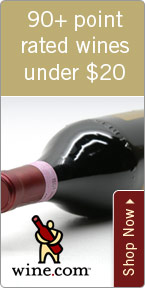The Simple Purity Of Unadulterated Wines

Wednesday - June 17, 2009
| Share
 Del.icio.us
Del.icio.usThere is a soap commercial that claims the soap is 100 percent pure. I always asked myself, 100 percent pure what?
So what is it when people speak of purity in a wine? I’ve said it myself. Unfortunately, pure does not always have such a pure meaning.
First, purity in wine as a definition should mean that the wine is completely unadulterated. It is simply the result of grapes being harvested, fermented and bottled.
How many wines do you know that are made this simply? There are a host of things that could adulterate a wine: added strains of yeast, any new wood aging, and additives including sulfur, acid, coloring, sugar and more. There also is the process of taking things out of wine such as filtering, fining, spinning, de-alcoholizing, de-acidifying, etc.
There are some wines made completely naturally with almost no additives at all and where no new wood is used to give any additional flavors: light, dry whites like Sauvignon Blanc, Pinot Gris, Chardonnay (i.e.) Chablis, Pinot Blanc, Greco di Tufo and Verdejo. Perhaps some of the best examples of this are wines that are fermented in stainless steel tanks that are inert and give no additional flavorings. Even some reds, mostly of the lighter variety, such as Gamay (Beaujolais), Pinot Noir, Tempranillo and more can be made without the addition of wood to keep them “pure.” In these wines, the purity factor is certainly quite high, some more than others.
But, in most cases, when writers use the word pure in describing the wine, I’m not sure they actually mean that the wine expresses the purity of the varietal from which it is made.
Even in that sense, especially in the old world, the grape also is a vector through which the earth can speak and influence the flavor of the wine. Chablis is a perfect example. Chardonnay grown in Kimmeridgian soil has a chalky character, almost oyster shell-like that is present in the palate. So even if the wine is unadulterated, is it truly a pure expression of Chardonnay or of Chablis? Certainly unoaked Chardonnay grown somewhere else would taste quite differently. So which one is the pure one?
Sometimes when people use the word “pure” they are actually talking about how the expression of a wine is so clear, without clutter and so clearly defined. Take, for example, a wine such as Donnhoff Oberhauser Brucke Riesling Spatlese. This wine is made from 100 percent Riesling and only from the Brucke vineyard in the Nahe, Germany. I read a review on it where the writer called it “pure.” In this sense, I think he meant that the wine is a pure expression of the complete terroir, Riesling coupled together with the soils of the Brucke vineyard. The expression of the vineyard was not obfuscated by winemaking or any other “artificial” flavors.
I also think that the purity of the wine comes from the fact that there is probably no other wine in the world that could possibly smell and taste like this one. This experience can only come from the purity of the winemaking and the expression of the vineyard that it allows.
Purity can come from a laissez faire-style of wine-making, by trying to do as little as possible to the wine in order to “let the vineyard speak.” It also can come from intervening only when needed at certain steps in the winemaking process.
In the end, I think purity is extremely difficult to find and even harder to attain. So when you find it, it is really something special.
Recommendations: 2007 Evening Land La Source Chardonnay ($89) Literally one of the best domestic Chardonnays I’ve ever had, period, full stop. Great complexity, intensity and balance. Scherrer Winery ZinfandelZinfandoodle V4.5 ($19) This non-vintage Zinfandel is playfully exuberant with black fruit, jam, spices and a flowery finish. This is so easy to drink, and great for barbecues!
Roberto Viernes is a master sommelier. E-mail .(JavaScript must be enabled to view this email address)E-mail this story | Print this page | Comments (0) | Archive | RSS Comments (0) |
Most Recent Comment(s):












